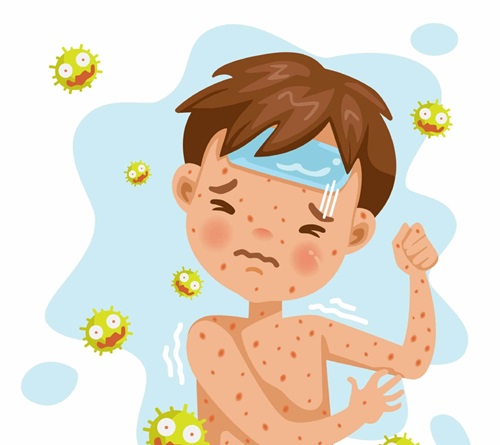
Asthma in Children
Asthma in Children:
Asthma is one of the most common chronic diseases that affect children, impacting their lifestyle in many ways. It can cause children to miss school or spend hours in the hospital. The first asthma attack is often frightening for children, especially since their bodies are not accustomed to the chest tightness, difficulty breathing, and wheezing. Although asthma can be worrying and uncomfortable at times, it can be controlled.
Asthma is known as a chronic lung disease that affects the airways and bronchial tubes that carry air to and from the lungs. These passages narrow, causing breathing difficulties accompanied by coughing and wheezing. Asthma comes in the form of attacks known as asthma attacks, often triggered by specific factors that incite the attack.
How does asthma affect the respiratory system:
Asthma causes chronic changes in the respiratory system, including:
- Inflammation of the airways: Studies show that airway inflammation is one of the most prevalent symptoms of asthma. Most asthma patients have some degree of inflammation at all times. When exposed to asthma triggers, cells lining the airways release mediators that lead to inflammation and increased mucus production, causing swelling and narrowing of the airways.
- Increased sensitivity of the airways to many substances that make asthma more severe: The inflammation in the airways makes these cells more sensitive to triggers, worsening asthma symptoms.
- Bronchospasm, which is the true constriction of the muscles surrounding the airways, leading to further narrowing of the respiratory channels.
Asthma and Children:
Asthma often begins during childhood, usually before the age of five. Many children suffer from asthma as it is a common condition at this age, with around 6 million children affected. The exact cause of asthma in children is not entirely known, but genetics and environment are believed to play a role in their development.
Who are the children most susceptible to asthma:
There is no definitive way to predict asthma occurrence in children, but studies have shown some predictors of asthma in children, including specific sensitivities such as skin allergies, food allergies, or allergic rhinitis. Family history of asthma or allergies, exposure to tobacco smoke before or after birth, obesity, living in areas with high air pollution levels, ethnicity (Black and African Americans are more prone to asthma), viral respiratory infections often trigger asthma attacks in young children, and finally gender (females in childhood and adolescence are more susceptible to asthma than males).
How does asthma affect the respiratory system:
Diagnosing asthma in children can be challenging, especially since children may hide many chronic symptoms before experiencing a severe asthma attack. Asthma can sometimes be confused with other respiratory conditions, and children may find it difficult to explain the symptoms they have experienced, especially during their first encounter with them.

It is important to consult a pediatrician if you notice that your child is experiencing one or more of the following symptoms:
- Chronic cough that worsens due to viral infections or strenuous activities like exercise or during sleep. Chronic cough may be the only symptom of asthma in children.
- Wheezing sound when the child breathes.
- Rapid breathing or shortness of breath, especially after exercise.
- Chest tightness, where the child may put their hand on their chest after exercise or complain of chest pain.
- Fatigue during exercise, you may notice that your child's activity level is lower than their peers and they get tired more quickly.
- Feeding problems and snoring during feeding (for infants).
- Daytime fatigue due to inefficient sleep or sleeping for few hours due to coughing, which may result in dark circles under the eyes as a sign of poor sleep.
- Withdrawal from social activities and a preference for non-strenuous activities.
These symptoms can range from mild to severe, but during an asthma attack, these symptoms become much worse. An asthma attack can occur gradually or suddenly, and the symptoms can be life-threatening.
Types of Asthma:
Asthma in children is usually classified based on the triggers that induce an asthma attack. Asthma triggers are anything that worsens asthma symptoms, and they vary from one child to another and can change over time.
*Allergic Asthma: This type of asthma is triggered by certain substances that cause an allergic reaction, such as pollen, pet dander, dust, some types of mold found in warm or humid areas.
*Non-Allergic Asthma: This type of asthma is triggered by substances that do not cause an allergic reaction, such as breathing in cold air or certain medications, household chemicals (cleaning products, laundry detergents, paint removers, insecticides), colds and viral infections, and finally tobacco smoke.
*Exercise-Induced Asthma: This type of asthma is triggered by engaging in certain physical exercises, especially when the air is dry.
Diagnosing Asthma:
Identifying the type of asthma is essential for treatment. It is important to inform the doctor about when your child's asthma attack occurs: at night or early in the morning, during physical activity, after exposure to specific substances like pet dander, during certain seasons, after laughing or crying.
Pediatricians rely on various tests to confirm a child's asthma diagnosis, including medical and family history, physical examination, chest X-rays, lung function tests (such as measuring breathing to determine lung efficiency), skin and blood allergy tests.
If the child is too young for lung function tests, the doctor may recommend giving some trial medications after suspecting asthma to see if the symptoms improve.
It is important to note that there are many conditions that may mimic asthma, such as seasonal allergies, gastroesophageal reflux disease (GERD), viral and bacterial infections, as well as conditions related to a child's anatomy, heart problems, and vascular issues.
Asthma Attack:
An asthma attack occurs when the symptoms of chronic asthma worsen. An asthma attack can happen even if the child's condition is usually under control. There may be warning signs that precede an asthma attack in children, and recognizing them can lead to quick treatment. These warning signs include mild coughing, rapid and irregular breathing, extreme fatigue, difficulty performing daily activities, restless sleep, stomach pain or headaches, and mood changes in your child.
When to Bring Your Child to the Nearest Medical Center:
- Severe and persistent coughing.
- Serious breathing problems and the child's inability to breathe.
- Changes in facial color, lips, or nails turning blue or very pale.
- Wheezing during exhalation.
Treatment of Asthma in Children:
The main goal of asthma treatment is to alleviate symptoms in children so they can lead normal lives like their peers. Asthma should be well controlled in children, with the child not experiencing symptoms more than two or three times or being awakened by asthma symptoms at night more than once or twice a month. There are several ways to control asthma:
- Avoiding asthma triggers: Try to keep your child away from substances that have previously triggered an asthma attack (triggers are discovered over time, so monitor your child closely as they may not know what caused the attack).
- Quick-acting medications, known as rescue medications, are given during or shortly before an asthma attack to alleviate symptoms. If these medications do not relieve symptoms, seek prompt medical attention. These medications include short-acting inhaled beta-agonists that open airways for airflow, oral corticosteroids that reduce swelling in the airways, short-acting anticholinergics, and long-acting inhaled bronchodilators.
- Medications for controlling inflammation and reducing airway constriction include corticosteroids, biologic drugs (such as benralizumab), leukotriene modifiers to reduce swelling, mast cell inhibitors, subcutaneous allergy injections, and long-acting inhaled bronchodilators.
Asthma medications come in several forms:
- Metered-dose inhalers (deliver a spray through a mouthpiece, providing high concentrations of medication to the lungs)
- Dry powder inhalers (require the child to breathe deeply and quickly to deliver medication to the lungs).
- Liquids for use in nebulizers.
- Injections.
- Tablets.
Inhalation forms are preferred as they reach the respiratory tract quickly, providing faster relief with minimal side effects.
How Parents Can Help Prevent Asthma Attacks as Much as Possible:
- Regularly consult the doctor and ensure an effective asthma control plan.
- Teach your child how to avoid asthma triggers and irritants.
- Ensure your child takes medications at specified times even if they feel fine.
- When your child experiences worsening asthma symptoms, they should take quick-relief medication (may be the same as routine medication but at a higher dose) and consult their doctor for appropriate medication during an attack.
- Ensure your child receives the COVID-19 vaccine and annual influenza vaccines.
- Use spacers with inhalers or nebulizers to make inhalation easier.
- Keep children away from others with colds and always encourage handwashing to prevent other illnesses as well.



